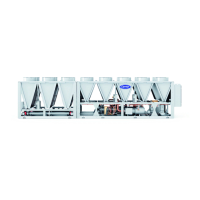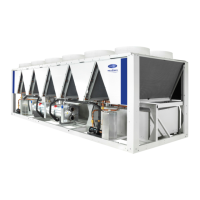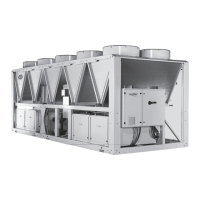33
DUAL CHILLER PUMP CONTROL FOR SERIES
CHILLER APPLICATIONS — Pump control for series
chiller applications is controlled by the master chiller only.
The control of the slave chiller is directed through com-
mands emitted by the master chiller. The slave chiller has no
action in master/slave operations. The slave chiller only ver-
ifies that CCN communication with the master chiller is
present. See the Dual Chiller Sequence of Operation section
on page 47. Figure 29 shows a typical pump arrangement
for dual chiller series applications.
Ramp Loading — The Ramp Loading function limits the
rate of change of the leaving fluid temperature. The minimum
compressor speed is calculated based on saturated condensing
temperature and saturated suction temperature. To enable the
Ramp Loading sequence:
Temperature Reset — The temperature reset function
will determine the cooling control point. This control point
is the active set point adjusted with the current reset value:
Control Point = Setpoint + Reset
The purpose of this reset value is to decrease the required
capacity if it is allowed by unit load operating conditions.
When a non-zero temperature reset is applied, the chiller con-
trols to the new control point instead of the set point. The type
of temperature reset is configured with the Cooling Reset Se-
lect variable. Four types of temperature reset are available:
Outdoor Air Temperature (OAT), Return Water Reset (Delta
T), 4-20mA control, and Space Temperature control:
Under normal operation, the chiller will maintain a con-
stant entering or leaving fluid temperature, based on the
configuration, approximately equal to the chilled fluid set
point. As the evaporator load varies, the evaporator fluid
temperature difference will change in proportion to the load.
For example, if the chiller was selected for an entering to
leaving water temperature difference of 10° F (5.5° C) at
full load, at 50% load the temperature difference would be
5° F (2.2° C). See Fig. 30. Because the change in tempera-
ture through the evaporator is a measure of the building
load, the temperature difference reset is the average build-
ing load. Usually the chiller size and fluid temperature set
point are selected based on a full load condition. At part
load, the fluid temperature set point may be lower than re-
quired. When the fluid temperature is allowed to increase at
part load, the efficiency of the machine will increase. The
chiller can also be set for return water temperature control.
See Fig. 31.
Other indirect means of estimating building load and
controlling temperature reset are also available and are dis-
cussed below.
To verify that reset is functioning correctly, subtract the
Current Setpoint (Main Menu General Parameters Cur-
rent Setpoint) from the Control Point (Main Menu General
Parameters Control Point) to determine the degrees reset.
DISPLAY NAME PATH VALUE
Ramp Loading
Enable
Main Menu
Configuration Menu
General Configuration
Yes
Cooling Ramp
Loading
Main Menu
Setpoint Table
Range: 0.2 to 2.0° F/min
(0.1 to 1.1° C/min)
Default: 1.0° F/min
(0.5 °C/min)
DISPLAY
NAME
PATH VALUE
Cooling Reset
Select
Main Menu
Configuration Menu
Reset Configuration
0 = None
1 = OAT
2 = Delta T
3 = 4-20 mA Control
4 = Space Temp
Fig. 29 — Typical Series Master/Slave Chillers
Dedicated Primary Pumping, Constant Flow, Leaving Water Control
CONTROL BOX
MASTER
CHILLER
LOAD
BYPASS LOOP
FIELD WIRING
FIELD COMMUNICATION WIRING
NOTE: This is a simplified wiring diagram.
Not all hydronic specialties are shown.
MASTER PUMP
ISOLATION
VALVES
CONTROL BOX
SLAVE
CHILLER

